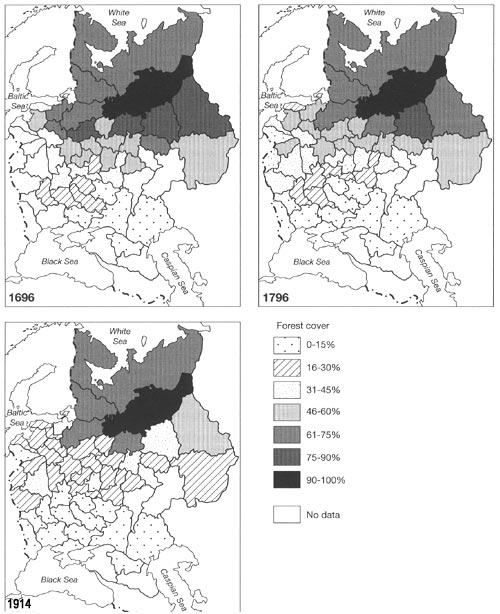Please put an active hyperlink to our site (www.rusnature.info) when you copy the materials from this page
Environmental problems of Northern Eurasia
Deforestation and Degradation of Forests
<<< Introduction | Environmental Problems Index | Classification
of Forest Resources >>>
The History and Scale of Deforestation
In comparison with north-western and Central Europe, deforestation in the FSU occurred
later. In the middle of the 14th century, oak forests surrounded Moscow and provided
timber for the construction of the Kremlin walls. In the 16th century, the oak groves in
Kuntsevo, a district in Moscow located less than a dozen kilometres from the Kremlin, were
the favourite hunting grounds of Ivan the Terrible. Forests surrounded the historical
cities of Kiev, Vladimir, and Suzdal. Similar to many other parts of the world,
deforestation in Northern Eurasia was prompted by the expansion of agriculture (Tsvetkov,
1957; French, 1983; Zharikov, 1991). Forest clearance proceeded most intensively in the
16th and 17th centuries as population increased and additional land was brought into
production. Arable lands, which originally were concentrated in river valleys, expanded on
to interfluves. It is at that time that irreversible changes in the landscapes of the East
European plain occurred. The intensive agricultural exploitation of cleared lands provoked
the widespread development of soil erosion and subsequent silting of river courses in the
central and southern East European plain. In more humid localities, impeded drainage
resulted in the development of swamps across the areas of forest clearance.
Apart from agriculture and the use of wood by local and national industries, the
destruction of woodlands was driven by the international timber trade which provided
substantial revenues to both the crown and private businesses. Mast timber was already
being exported from the port of Kholmogory on the White Sea during the reign of Ivan the
Terrible, and since the 17th century a steady increase in timber export from Russia has
been observed, originally through the White Sea and after the conquest of the Baltic from
the Baltic ports (French, 1983). Between 1860 and 1913 the average annual value of
timber-product export increased from 6 million rubles to 164 million and the volume of
timber transported by the Russian railways increased by a factor of four (French, 1983).
Since the second half of the 17th century, the northern provinces have also supplied wood
for paper manufacturing. Originally centred around St. Petersburg, the industry spread
north to the Arkhangelsk province and west, into the Baltic provinces and Belorussia
(Belarus). At the beginning of the 20th century, national (excluding Finland and Poland)
production of paper and cardboard exceeded 300 000 tonnes a year (French, 1983).
Between the end of the 17th century and the beginning of the First World War, the
forested area in the European part of the Russian Empire (excluding Poland and Finland)
declined from 53 per cent to 35 per cent of the total territory (Tsvetkov, 1957). The
disruption of woodlands was particularly strong in the northern Ukraine, Central, and
Southern Russia (Figure 23.2).

Fig. 23.2 Change in forest cover in the European part of the Russian
Empire between 1696 and 1914. Compiled from data from Tsvetkov (1957)
For example, in the Tver and Poltava provinces the share of forested areas declined
between 1696 and 1914 from 76 per cent to 23 per cent and from 26 per cent to 5 per cent,
respectively (Tsvetkov, 1957). Forests of the northern provinces were impacted later than
forests of Central Russia. For example, in the Pskov province the share of forested area
declined from 65 per cent to 54 per cent between 1696 and 1796, while in 1914 forests
occupied only 25 per cent of the province (Tsvetkov, 1957).
Irremediable damage has been caused to the montane forests of the Caucasus and
Transcaucasia. Human-induced forest clearance and soil erosion, associated with it, has
transformed much of the originally forested mountains of Azerbaijan into lifeless
wastelands dissected by ravines. In some areas of the Northern Caucasus, valuable tree
species were replaced by inferior woody plants (e.g., oriental hornbeam, aspen, and
willow) and locally by wastelands.
<<< Introduction | Environmental Problems Index | Classification
of Forest Resources >>>
Contents of the Deforestation and Degradation
of Forests section:
Other sections of Environmental Problems of Nortern Eurasia:
|
|